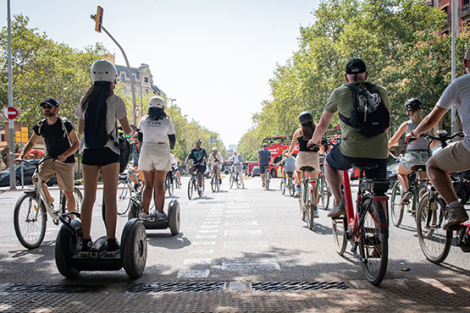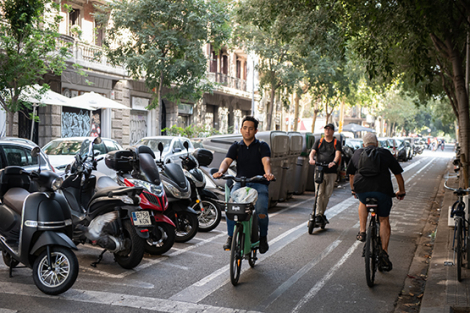Use of space and mobility management
- Urban visions
- Oct 23
- 9 mins

If Barcelona’s streets could speak, they would tell us that they have never seen so many different vehicles using their surface, and that they have never witnessed such rapid and drastic changes in mobility as in recent years. In contrast, policies and regulations often come to fruition more gradually. Confronted with these challenges, reflection is needed to gain a better understanding of the state of affairs and to find ways to manage space in a fairer and more accessible manner.
Barcelona is a very dense city, with an enormous shortage of green spaces and a high concentration of air pollution. It is in this urban context that mobility takes place. The space allocated to mobility is often organised hierarchically, classifying roads as basic (where priority is given to through traffic), local (to facilitate traffic continuity) and people-centred (where priority is given to the mobility of pedestrians and cyclists). This hierarchical organisation of road space based solely on mobility criteria hinders the consideration of other street functions, such as placemaking, which facilitates social interaction (space to stop and greet a neighbour), wellbeing (spaces where the elderly can sit and rest in the shade) and play (spaces where children can play), for example.
The function of streets as a place to stop and spend time is not strictly considered mobility, but movement is necessary to reach another place where the priority is not just to get around and where basic social needs can be met. Mobility management must address these requirements, since everyone, whether living or getting around in one kind of street scenario or another, has needs and rights related to mobility. Therefore, the first idea is that, to manage space for mobility, we should not only think about mobility itself, but also about other functions of thoroughfares that make them real streets.
 Different kinds of vehicles share space on Passeig de Sant Joan, near Plaça de Tetuan. © Albert Armengol
Different kinds of vehicles share space on Passeig de Sant Joan, near Plaça de Tetuan. © Albert ArmengolQuantity as well as quality
Space divisions are usually defined by architectural barriers or changes in ground level (pavement-roadway), paint (traffic lanes) or street furniture (protective street furniture for the cycle lane, bollards, etc.). These elements create the impression that the space is divided into compartments and that each section is intended for specific mobility uses. Nevertheless, in reality, there are parts of these compartments, or moments, when these uses are mixed, whether in accordance with regulations or not. For example, when there is a pedestrian crossing on the roadway or when motorbikes park on the pavement.
Assumptions tend to be made, such as that the amount of space available for each vehicle should be correlated with its modal share. For example, a much larger amount of space is allocated to cars than would correspond to the percentage of journeys they are used for. While it is true that this is not fair, these correlations are not so relevant when applied to public transport, cycling or pedestrian mobility, where the proportion of journeys may be lower than the amount of space devoted to them, and that does not mean said amount should be reduced! There are forms of mobility that require more surface area to make them sufficiently safe and convenient for all users. Moreover, these estimates do not consider the fact that there are spaces that are used on a shared basis.
Thus, it is not only about the amount of space allocated to each form of mobility, but also about the quality, which is influenced by both the physical part (width, type of surface, lighting, etc.) and the conditions in which it is used (speed, right of way, etc.). Each form of mobility has characteristics that determine where it is most appropriate, such as space requirements (dimensions, turning angles); ideal starting, average and maximum speeds; trajectory; air pollutant and noise emissions; etc.
In the case of electric kick scooters, it is a motor vehicle in which the person’s body is exposed (as opposed to a car, in which the person is protected inside a cubicle) and the driver stands on a platform with two wheels, holding on to a handlebar for steering. Given these characteristics, it makes sense to set a speed limit and prohibit their use on pavements and streets with speed limits above 30 km/h.
Furthermore, if two types of vehicles, such as mostly non-motorised bikes and electric kick scooters, coexist in the same spaces – cycle lanes – these lanes will have to be widened so that motorised vehicles can overtake non-motorised vehicles without raising the risk of accidents or the perception of risk (which can change people’s behaviour, especially those who feel more insecure, such as female cyclists)[1].
The second idea is that space should be managed not only in terms of quantity, but also in terms of quality, focusing on the basic characteristics of vehicles and considering the most appropriate conditions in each section of the street space.
 Different kinds of vehicles share space on Passeig de Sant Joan, near Plaça de Tetuan. © Albert Armengol
Different kinds of vehicles share space on Passeig de Sant Joan, near Plaça de Tetuan. © Albert ArmengolPublic-private management
In recent years we have seen the emergence of private companies offering mobility services to citizens, making fleets of bicycles, motorbikes and electric kick scooters available to customers[2]. Nobody would think that any company could offer bus lines that were not approved by public transport agencies and therefore did not meet a series of service quality, accessibility and safety requirements. On the other hand, the same conditions do not seem to have been applied to shared, single-use and two-wheeled vehicles, although a transport service is also offered to the public.
We have also seen how private mobility service providers with fleets of shared bicycles and scooters have been allowed to use public spaces and infrastructure, such as bicycle racks, as a requirement in order to operate. The private use of space and the privatisation of public mobility services forces us to ask ourselves about the extent to which the right to mobility can be compromised, as well as the extent to which the responsibility for the provision of certain mobility options can be left to private companies. A permit system can be put in place, or a tender can be organised and a contract signed, but any such formalisation of a public-private partnership must ensure that it offers decent levels of quality, fairness and safety in the service it provides to the public.
This third idea invites us to consider bicycles or scooters – or any other transport vehicle or device – as a mobility system and that, therefore, when it is offered as a service provided for a private entity, it should still be managed as a mobility service, even if it is an individual vehicle.
How could space management for mobility be improved?
I would like to briefly point out two tools that are already showing promising results. The first is evaluation and its importance. Whatever policies are implemented, we lack agility and practice in these systems. Impact assessment must be conducted, to measure the before and after, as well as the evaluation prescribed for the planning tools themselves, specifying the indicators to be measured, the methodology and frequency, the cost, and the body responsible. When we do not have data, or when we do, but they are not rigorous, the capacity to make informed decisions is very limited and there is a high risk that the interventions carried out will not deliver the expected results. This is when we allow beliefs to become the grounds for decision-making, such as when we want to turn shopping areas into pedestrian priority zones, and believe that “if cars cannot park, people will not shop”. There is plenty of evidence to show that this is not the case, but it must be used. I would like to emphasise that the evaluation must be based on fairness criteria. For instance, we should disaggregate data by population groups (gender, level of income, migration status, age, disabilities…). We must also ask ourselves who benefits from the policies that are implemented and who does not, because we cannot allow public policies to be biased in favour of certain privileged groups.
The second tool is co-production to create a sense of ownership. Co-production is an evolution of the concept of citizen participation. Participation alone is not enough: it calls for a commitment to taking shared needs and proposals into account. When we align the contributions of citizens’ organisations with those of public institutions, it is easier to achieve a sense of belonging whereby we feel that the street is ours too and that everyone is welcome there. Even if the streets created as a result of co-production are not exactly as we would like them to be, we have our space there. And we know that we can also make mistakes and rethink it if we don’t get it right the first time; mobility is a complex issue. Participatory budgeting is an example of such practices. In conclusion, I would like to close by recalling that, to envision a better future, we must base ourselves on knowledge of the reality, a capacity for evaluation, and the execution of thoughtful and empathetic communication of the needs of the parties involved.
Notes
[1] Col·lectiu Punt 6 and Anaya, E. Recomanacions per integrar una perspectiva feminista interseccional en la mobilitat ciclista de Barcelona. Barcelona, 2021. via.bcn/TwcR50PcyRK
[2] In Barcelona, the rental of shared scooters has been banned since 2019, pending a regulation to govern it.
The newsletter
Subscribe to our newsletter to keep up to date with Barcelona Metròpolis' new developments




